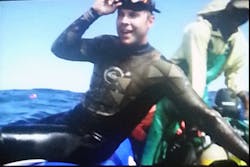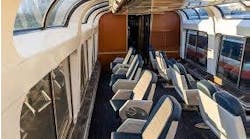A vampire ball in New Orleans and sea turtle rehabilitation aren't normally things I think of when I think of public transportation, but they forever will be after listening to National Geographic Contributor Andrew Evans. He spoke at the South West Transit Association's Annual Conference and Expo about some of his adventures, including traveling 12,000 miles by bus to Antarctica.
And then I was faced with a dilemma. How do I write about something when not only was he a great speaker, he is a great writer that has already written about much of what he was speaking about. In fact, many of you may have already read Bus2Antarctica on National Geographic’s website.
So what I leave to you here are some of the stories that resonated with the crowds. Ones that made people laugh, choked people up, and brought them to their feet at the end.
He began the presentation sharing numerous stories from the adventures his job takes him on and would end each coming back to how it's transportation. Two of my favorites were attending a vampire ball and swimming with great white sharks.
While he was in New Orleans he received an invite to attend a vampire ball and he spent the evening talking to a variety of "creepy people," including the host. Spending that time he said he got to know a lot about him, including the fact he's a phlebotomist by day. Evans ended the story saying sitting next to and meeting someone you wouldn't normally in a million years, this is public transportation.
The people at my table all looked at each other and laughed as we all have a story or two of sitting next to someone on the bus that resulted in a weird or hilarious story.
When telling about swimming with the sharks, he said he was taken seven miles out into the ocean in a tiny rubber raft. Sharks don't like people, he explained. They're shy and need to be lured in. To do so, they dump blood and fish guts into the ocean to attract them; it's the only way to get sharks there. Within minutes, the water was swarming with sharks. This is transportation, he said. They had created a hub. There was public opposition in Houston; everyone moaned about rail, he explained, but once they built it, people loved it. You dump blood in the water and they will come; build it and they will come.
The stories he told were from around the globe. Yet there was one place he always wanted to go but hadn't been able to get to. Unless you’re rich, a scientist or in the military, he said you’re not going to get to Antarctica. It was his allusive dream he was chasing.
He then decided he would do it. He would take public transportation to get to Antarctica.
The contrast of his U.S. bus travels and South American bus travels are hilarious and sad, all at once. Oh so much we take for granted here in the United States.
He packed a bag and sent two suitcases with cold-weather gear then grabbed a bus in D.C., for $1.35 to the Greyhound station. He got to the station, the person behind the ticket counter asked where his final destination was, he said Antarctica. “How about we get you to Atlanta,” the rep said.
You can’t understand what public transportation is like, Evans said, until you’re the minority. When in Montgomery, Ala., he had a moment where he remembered it’s a civil right that we have fought for to ride the bus without discrimination. “We have led the world in this belief,” he said.
What followed through the South American adventures was corruption, danger and even prestige. A surprising combination, for sure.
In Mexico bus drivers make “illegal” stops for kick-backs from the diner owners. In Guatemala, you’re riding among chickens, live music, there aren't set stops and you just jump out the back when you get to where you want.
And then you get to El Salvador where you ride with a private armed guard. And they take a picture of your face before you get on in. You know, in case you are killed if the bus is hijacked.
In Nicaragua, buses won’t even run at night because it’s simply too dangerous.
People are willing to risk their lives in order to ride the bus.
In Columbia things are even rougher than Nicaragua. There were people praying on the bus, prayers written on the walls of the station and prayers written on the buses themselves. Yet people still ride the bus.
About 4 in the morning, the bus Evans is on hits something. The axle breaks. The bus rolls off the side of the road. It was pitch black and no one was moving; no one was talking. But people were crying.
Any moment someone was going to come on and start shooting. But the naïve American stood up and asked what was going on. People pleaded for him to sit down and be quiet but Evans got off the bus with the light of the flash of his camera to see what had happened. His foot hit something big and heavy: a cow. Everyone was so happy and relieved; they weren't going to die.
In many areas he described the prestige of riding the bus. In Ecuador bus drivers are very respected and their buses are their castle. The drivers run the show; they control the roadway.
In the Andes, a rock crushed a bus and the driver of Evans’ bus jumped out, ripped out the windshield of the crushed bus, took out the keys and pulled the two operators out to safety.
When getting stuck in mud in Bolivia, where there are no paved roads, everyone gets out and pushes the bus because, Evans said, “We were all in this together.”
The most incredible was Argentina. Evans said there was a very sophisticated transportation network with very efficient and very good roads. The buses were luxurious with soft, cushy seats that recline, individual flat-screen TVs full of movies, and food being brought by every couple hours.
Most people in my community wouldn’t ride a bus even if they were driven to the stop and given a free pass. It’s quicker, easier, more comfortable to drive themselves and they don’t want to risk sitting next to a crazy, dirty, scary person. Or what ever other reasons they have ... you've all heard all of them before.
But for Evans? “Riding the bus over 10,000 miles allowed me to reach my dreams.”
And for people he was riding with along his journey, they were willing to risk their lives to take the bus. They felt pride in taking the bus.
Evans showed a picture of Earth from space; an image we've all seen countless times. You think it’s this huge, immense thing we look at and fly around, but once you ride a bus and can measure the distance in your own experience, he explained, it is small.
“This is what you do,” he told the attendees. “You make the world smaller for people who otherwise, this distance is impossible. You make the world smaller for other people.”
The presentation ended with Evans showing photos from a sea turtle rehabilitation center he had visited. They were missing limbs from nets, sharks, other dangers. A Green Sea Turtle named Allison lost all but one flipper and sea turtles need to be able to swim to stay alive. An intern, who was also a surfer, designed a contraption to strap on to Allison and it allowed her to swim. Evans said it reminded him that every life is worth living.
This turtle had a life and this is transportation, he reiterated.
“You take people and help people who can’t get from A to B on their own,” he said. “You give them freedom. You give them life.
“It is your gift to the world.”



